NEOLITIC
8000 BC
-
1000 BC
An early village is known from the Neolithic period. It was established around 4500 BC on the rocky spur and was occupied until the end of the Bronze Age, in the first millennium BC. The site mainly revolves around the dungeon of Gouzon area, with some remains discovered around the castle of Montléon's area and at the chevet of the Saint-Pierre collegiate church. Archaeological excavations have revealed the presence of post holes, ditches and pits. A large ditch protected the village to the north and contained ceramic and flint tools and food waste.
In the Neolithic period, people worked with flint and bone to create tools for hunting (arrows), gathering meat (scrapers) or cleaning and processing the skins of killed animals ( smoothers, punches). They also used other tools such as axes, pebbles and polishers, and made earthenware containers to hold seeds or fruit, for example.
Around 3500 BC, humankind discovered copper and later mixed it with tin to make bronze. The latter, when subjected to fire, became molten, before being poured into stone or earthen moulds. This made it possible to produce weapons, such as the axe of Leignes-sur-Fontaine, and ornaments, such as the very beautiful bracelet of Cubord.
This ditch is still visible on the ground floor of the dungeon of Gouzon
MODERN TIMES
19th century
In 1882, the railway arrived to Chauvigny and gave commercial travelers the opportunity to visit the town, which had become particularly dynamic thanks to important fairs and the establishment of two industries: limestone extraction and a pottery factory. Between 1880 and 1900, several major projects were carried out: the boulevard towards the upper town, the Town Hall and a school complex, whose purpose was to offer both boys and girls a good education.
The medieval bridge, which was already in disrepair when Louis XIV came to Chauvigny, was replaced by a ferry until the beginning of the 19th century. It was not until 1833 that a "wire" bridge was built upstream. In 1864, a stone bridge replaced it, but it was destroyed in 1944 and rebuilt in 1948.
The practice of photography developed in the 19th century, with photographs being taken using glass sheets. In 1851, as part of a survey of medieval castles in France (the Mission Héliographique), the photographer Gustave Le Gray took the first photographs of the town; others followed: Alfred Perlat, Célestin Sicard, Jules Robuchon, etc.
MIDDLE AGES
5 thcentury
-
15th century
The Chauvigny lordship became part of the temporal domain of Poitiers' Cathedral in the 11th century. Thus, all of the bishops appointed to Poitiers took the title of lord of Chauvigny. The first to be identified was Isembert, around 1020, who owned a family castle in Chauvigny. The medieval town of Chauvigny is unique because it holds five castles, all of which have coexisted. There is no other example in Europe of such a high concentration in such a small space. This can be explained by the lordship of Chauvigny. The bishops of Poitiers were also lords, so they had the prerogatives, due to their position; they could administer justice and collect taxes. On the other hand, their religious status did not allow them to hold military functions, nor to possess an army. In order to defend themselves, they therefore called upon other lords, some of whom were related to them, who came to settle nearby to protect them and defend the town of Chauvigny. The town of Chauvigny was divided into two distinct areas: the upper town, on the rocky spur, was home to the civil and religious authorities; the lower town, which was built on its outskirts, was home to the population as well as the industrial, craft and commercial areas.
5 castles in Chauvigny!
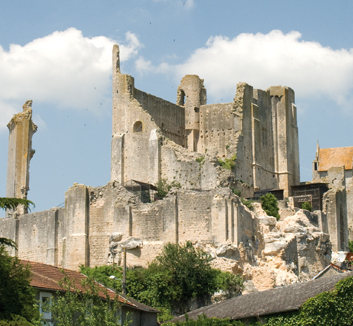 This castle, called " Bishop's castle " and then " Baronial castle " in the 14th century, still has most of its walls, its Romanesque dungeon, its " bastion " and the flattened remains of numerous small buildings in the courtyards. As for the dizzying vertical wall, it is the last witness of a second dungeon built at the dawn of the 15th century.
In the 18th century, the bishops were no longer responsible for the upkeep and maintenance of the building. Afterwards, the Baronnial castle was sold as national property in 1792 and transformed into a public stone quarry. Finally, it was classified as a historical monument, then bought by the State in 1843. Since 1996, the castle has been the venue for a falconry show.
This castle, called " Bishop's castle " and then " Baronial castle " in the 14th century, still has most of its walls, its Romanesque dungeon, its " bastion " and the flattened remains of numerous small buildings in the courtyards. As for the dizzying vertical wall, it is the last witness of a second dungeon built at the dawn of the 15th century.
In the 18th century, the bishops were no longer responsible for the upkeep and maintenance of the building. Afterwards, the Baronnial castle was sold as national property in 1792 and transformed into a public stone quarry. Finally, it was classified as a historical monument, then bought by the State in 1843. Since 1996, the castle has been the venue for a falconry show.
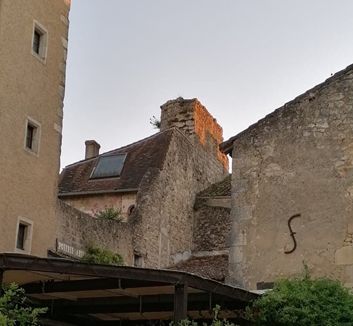 The original name of the castle of Montléon is Oger Tower because of the Oger de Chauvigny family, ancestors of the lords of Montléon. Interestingly, the inscription "Tour Oger" appears on a window sill at the site of the castle, near the collegiate church.
All that remains of the castle of Montléon is a piece of its enclosure and a coat of arms with a lion with a fire tongue, visible above a door: the remains of this castle are dated from the 13th century. It was similar in size to the castle of Harcourt; these two fortresses therefore blocked the direct access to the Bishops' castle.
The original name of the castle of Montléon is Oger Tower because of the Oger de Chauvigny family, ancestors of the lords of Montléon. Interestingly, the inscription "Tour Oger" appears on a window sill at the site of the castle, near the collegiate church.
All that remains of the castle of Montléon is a piece of its enclosure and a coat of arms with a lion with a fire tongue, visible above a door: the remains of this castle are dated from the 13th century. It was similar in size to the castle of Harcourt; these two fortresses therefore blocked the direct access to the Bishops' castle.
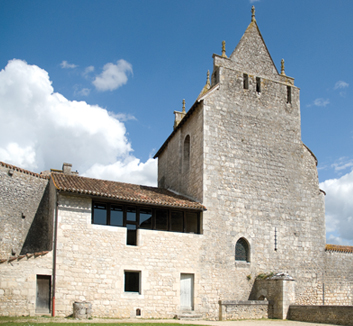 The castle, built in the 12th and 13th centuries, belonged to the Viscounts of Châtellerault. It came into the domain of the Harcourt family at the end of the 13th century when Jeanne of Châtellerault married Jean II of Harcourt. The entrance châtelet still has a guard room, a knocker and a place for the portcullis. The courtyard contained outbuildings (kitchens, chapel) which have now disappeared. The dungeon was formed by two towers. A beautiful medieval room has been preserved on the first floor, which was accessed by a ladder in the place of the current window. Shortly after the bishops acquired the castle, at the end of the Middle Ages, it was turned into a prison. The cellars were used as a prison until the beginning of the 19th century
The castle, built in the 12th and 13th centuries, belonged to the Viscounts of Châtellerault. It came into the domain of the Harcourt family at the end of the 13th century when Jeanne of Châtellerault married Jean II of Harcourt. The entrance châtelet still has a guard room, a knocker and a place for the portcullis. The courtyard contained outbuildings (kitchens, chapel) which have now disappeared. The dungeon was formed by two towers. A beautiful medieval room has been preserved on the first floor, which was accessed by a ladder in the place of the current window. Shortly after the bishops acquired the castle, at the end of the Middle Ages, it was turned into a prison. The cellars were used as a prison until the beginning of the 19th century
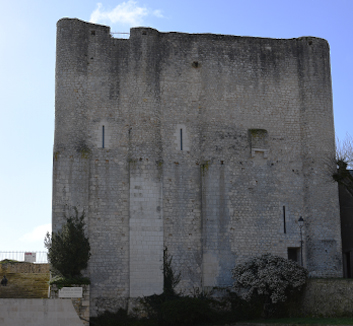 This castle owes its name to Guy III of Gouzon, a lord of the Bourbonnais, who married Blanche of Beaumont, the owner of the fief, at the end of the 13th century. Acquired by the bishop Fort d'Aux, around 1350, it was used as a watchtower until the 17th century. It underwent several restoration campaigns before housing a museum in 1993: the Industrial Archaeology Centre.
This castle owes its name to Guy III of Gouzon, a lord of the Bourbonnais, who married Blanche of Beaumont, the owner of the fief, at the end of the 13th century. Acquired by the bishop Fort d'Aux, around 1350, it was used as a watchtower until the 17th century. It underwent several restoration campaigns before housing a museum in 1993: the Industrial Archaeology Centre.
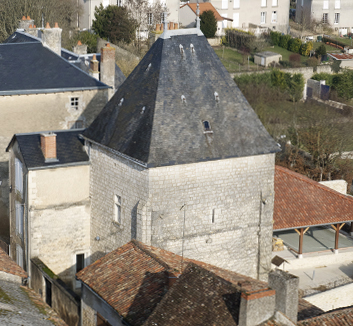 This is the only castle that the lords of Chauvigny did not attempt to acquire. Therefore it has remained private. Even though it is the smallest of the Chauvigny's castles, it is without doubt the best maintained in its original condition. The modifications made date from the Renaissance era, with the creation of windows, the filling in of the battlements and the addition of a four-sided roof. Nevertheless, the volume of the tower has been preserved.
This is the only castle that the lords of Chauvigny did not attempt to acquire. Therefore it has remained private. Even though it is the smallest of the Chauvigny's castles, it is without doubt the best maintained in its original condition. The modifications made date from the Renaissance era, with the creation of windows, the filling in of the battlements and the addition of a four-sided roof. Nevertheless, the volume of the tower has been preserved.
Its position, to the north of the rocky spur, gives it the appearance of a watchtower which could provide a first line of defence for the town.
ROMAN TIMES
1st century BC
-
5th century AD
In Roman times, the rocky spur was abandoned in favour of the Vienne valley. A small Ancient settlement of 10 hectares developed near a ford crossing the river and the Poitiers-Bourges Roman road; it is known as Saint-Pierre-les-Églises. Archaeological excavations have revealed remains of housing and crafts dating from the 1st to 4th centuries AD. The settlement disappeared from the 5th century onwards. A Christian sanctuary consisting of a church and a vast Merovingian necropolis was built on the site. Nowadays, Saint-Pierre-les-Églises appears as an isolated church in the middle of its cemetery. The construction of the church is not precisely dated, but the construction materials suggest the reuse of the Ancient roman buildings. Some elements (milestone, capitals, tombs) testify to the wealth of the Roman site.
The Gallo-Romans had a wide variety of toiletries; pins were used to hold the hair, small spoons and bronze sticks were used to clean the nails or ears and to prepare beauty creams. To tie up their clothes, they used the fibula, which could also be decorated and serve as a piece of jewelry.